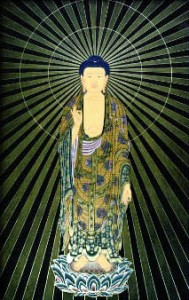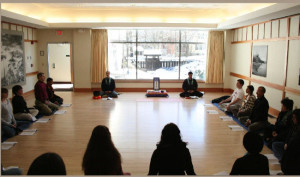Beginning Your New Life
In the 21st century, Buddhism has become the fastest growing religion among native-born Americans. Many people these days are reading books about Buddhism, practicing Buddhist meditation, employing Buddhist psychology, and applying Buddhist ideas at work, play, and with relationships. If you are one of those who are very interested in walking this path, you may one day decide to formally become a disciple of Buddha in order to formally live the path of understanding, faith, and love. The information below will help you familiarize yourself with the 4 Steps to become a Buddhist and answer the questions on what does it meaning to Take Refuge in the Three Jewels and the Five Precepts.
STEP 1: Know the Basics
If you would like to make Buddhism your religion, there are some things to consider. First, you should be familiar with the life of the historical Buddha, the basic history of the religion, and its tenants such as karma, rebirth, Four Noble Truths, the Noble Eightfold Path, and the Five Precepts. It is not necessary to accept all of the Buddhist teachings in the beginning, but one should be willing to consider them. The Buddha never asked his disciples to believe something just because he said it. He said that one needed to prove it true for oneself.
STEP 2: Understanding is Important
In Buddhism, understanding is the most important thing and this takes time to develop. So do not impulsively rush into Buddhism. Take your time, ask questions, consider carefully, and then make your decision. The Buddha was not interested in having a large number of disciples. He was concerned that people should follow his teachings as a result of a careful investigation, consideration of the facts, and most importantly personal experience.
STEP 3: Engage with the Sangha and Dharma
Join a Buddhist sangha (a temple, church or group), support them, be supported by them and continue to learn more about the Buddha’s teachings. Read about the dharma, apply it in your life, regularly attend our Sunday morning Practice & Talk meetings and retreats, become a supporting member, and let your heart and mind open to the working of dharma and the Great Compassion. At the Buddhist Faith Fellowship, we highly suggest taking a beginner’s course in our Buddhism 1.0 series (currently not offered) to learn about the basics. Also, we offer a Growth Track to help guide you on your journey. Then, when you are ready, you can formally become a Buddhist by undertaking the Affirmation or Ordination Ceremony.
STEP 4: Becoming a Buddhist
The decision to formally become a Buddhist is marked by either Affirmation or Ordination Ceremony. These two types of ceremonies are different but share certain religious aspects.
Affirmation

First of all, the Affirmation Ceremony or the Kikyoshiki in Japanese is unique to lay organizations like Shin Buddhism. It is a form of personal religious confirmation, in which the participant publicly acknowledges his/her orientation and commitment to the Buddha, Dharma and Sangha. At the Buddhist Faith Fellowship, one must successfully take a few basics courses like those offered in our Buddhism 1.0 series (currently not offered) in order to participate in this ceremony. We believe that one should have some background in the Buddha’s life, teachings, and practices in order to undertake such an important life-changing ceremony.
As stated above, this ceremony is unique to lay Buddhist schools and not offered with religious orders. Like other schools, this ceremony does entail the transmission of the Three Jewels and the Five Precepts from a qualified teacher or organization to a student.
As stated above, the Affirmation Ceremony allows the participant to publicly acknowledge his/her personal faith in the Buddha (the historical and the universal), the Dharma (the teachings and the reality-as-it-is) and the Sangha (those who have trust in and practice the dharma). Furthermore, the Affirmation Ceremony confirms the Five Precepts as the best ways to compassionately live in our suffering world. These precepts are an ethical code that serve as skillful guidelines to live a flourishing life (see below for more on the Precepts).
An important part of the process is for Affirmees to choose a Buddhist name that strives to best define their spiritual journey or one that challenges or inspires. During the ceremony, an Affirmation Certificate and Buddhist kata (monto shikisho) are given to Affirmees. The kata is symbolic of the robes that monks wore, and so in a gathering one dons the scarf as a way of showing that they formally took refuge in the Three Jewels – Buddha, Dharma, and Sangha. There is usually a small donation requested to cover the costs.
Ordination
The Ordination Ceremony is similar to the Affirmation Ceremony but is only granted by a fully ordained monk, in whom the lay participant receives a teacher to student, transmission of the Three Jewels and the Five Precepts, and with Mahayana schools, the Bodhisattva Vows. The participant is then ordained as a lay follower or as it is called in Sanskrit, an upasaka (ordained lay male follower) or upasika (ordained lay female follower). The ordained then receives a certificate and a Buddhist name. The name is not chosen by the ordained but by the conferring monastic.
This ceremony contrasts with the Affirmation Ceremony in that the ordained lay member is formally initiated or becomes linked to the monastic order of the presiding monastic. In some schools the conferring monastic is considered as the lay follower’s principal teacher or as his/her devoted guru. These ordained lay followers may then, in the future, decide to intensify their practice and become fully ordained as monks (bhikkus) or nuns. The Ordination Ceremony is conducted by monastic orders only. Since the Buddhist Faith Fellowship is not a monastic order, it does not conduct ordinations. If you are interested in lay ordination please refer to a local Buddhist temple or center with a resident monk or nun.
What is the meaning of taking refuge?
To publicly take refuge in the Three Jewels is to change the direction of one’s life and make an effort to embody the Buddha, the Dharma, and the Sangha.
1. To take refuge in the Buddha is to take refuge in the living source of understanding, faith, and compassion, personified as the Buddha of Boundless Compassion and Wisdom and her historical human manifestation, Shakyamuni Buddha. One sees the historical Buddha as the greatest teacher and the embodiment of our true human potential to live a flourishing life of happiness, well-being, and tranquility of mind.
2. To take refuge in the Dharma is to take refuge in Reality-as-it-is, the Ocean of Oneness, the Buddha’s teachings and the path of understanding and compassion.
3. To take refuge in the Sangha is to take refuge in the community that practices according to the Buddhist path and strives to manifest and embody enlightenment here on Earth.
The Three Jewels are present in every quarter of the universe. This means they preside in our hearts, in every person, and in all other species inhabiting unseen countless worlds across the universe. By dedicating ourselves to learn, entrust, practice and embody the Three Jewels, you will have the proven vehicle to nourish the ability to love and understand within ourselves.
The Affirmation ceremony is the decisive step in becoming a disciple of the Buddha. In this ceremony, you begin the process to be transformed from within. Gradually, over time with patience and diligence, you will be enabled to deeply realize that each of us is the main concern of the Great Compassion. As the great Japanese reform Shinran Shonin said, we who are like rubble will be turned into gold.
What is the meaning of taking the Five Precepts?
An essential part of the Affirmation and Ordination ceremonies is the reciting of the Five-fold Precepts. They are not rules or commandments but are guidelines to wholesome and ethical living that truly witness our commitment to live an awakened and faithful life. The Precepts have the power to protect life and make our lives beautiful; they help give us the space to respond to life’s challenges and blessings with understanding and love. Through the working of Great Compassion and our skillful diligence, we are empowered to better practice them and are encouraged to move forward in the direction of peace, joy, and awakening. Likewise, they are the foundation for the happiness of the individual, family, and society. These Precepts help us avoid making mistakes that create suffering, fear and despair but instead bring understanding and compassion into our lives, and our lost and suffering world.
The Five Precepts are as follows:
- I practice love, I refrain from killing.
- I practice generosity, I refrain from stealing.
- I practice contentment, I refrain from sexual misconduct.
- I practice mindful speech, I refrain from harmful speech.
- I practice mindful consumption; I refrain from intoxicants and harmful substances that harm my mind and body, society and the environment.
A Path for All
We are talking about walking on a wonderful path and living a new kind of lifestyle. For over 2,500 years, Buddhism has been a proven path for tens of millions of adherents. It may be the time for you to travel it too. Understand this is completely possible; there is no reason at all that you cannot travel this path. This is the beauty of the teachings: it is completely available to all whether we are saints or sinners, ignorant or wise, young or old. Great Compassion always remains with us unconditionally shining her light. She is moving, seeking, and working to liberate you from suffering (dukkha). Just relax, entrust, put into practice, and give thanks.

